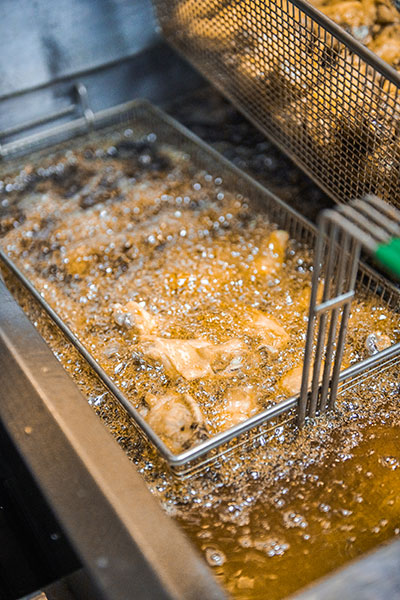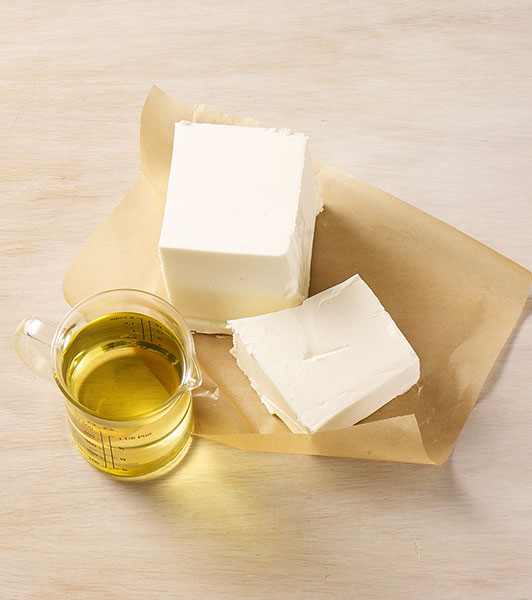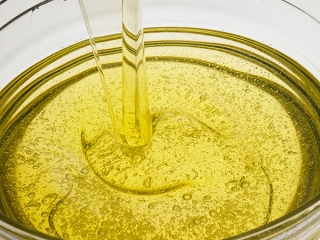Five years ago, the edible oil industry lost traction when the FDA determined that widely-popular hydrogenated oils were not safe because of their trans fats and contribution to heart disease. Bakers and cooks began looking for healthier replacements. That’s when newcomer-to-the-market high oleic soybean began to climb up the slippery oil slope.
Made from soybeans grown only in the US, high oleic soybean oil is an attractive option for foodservice use because of its neutral flavor, long shelf life and improved fat profile.
Plant-based
Either in shortening or oil form, high oleic soybean oil is high in monounsaturated fat, the healthy fat found not only in soybeans but also olive oil, nuts and avocados. These fats can help reduce the risk of heart disease, decrease inflammation and help with weight loss.
Not to be confused with conventional soybean oil or shortening, high oleic soybean oil undergoes a chemical process that creates a more stable product and healthier replacement for high cholesterol animal fats like butter and lard or banned partially hydrogenated oils.
High oleic soybean oil and shortening also feed squarely into the plant-forward trend of today’s diners. (Click here to read a Meet the Grower article about soybean farmer Jeremy Rittenbach and learn more about the care and work that goes into cultivating soybeans.)
Benefits of oil  High oleic soybean oil can be used in its liquid, room temperature form in cooking and frying applications.
High oleic soybean oil can be used in its liquid, room temperature form in cooking and frying applications.
Instructors know oil used in restaurant fryers have a definitive life cycle and should be replaced from one to two times per week, depending on its utilization. Also, if a poor-quality oil is used, then cleaning the fryer becomes more difficult resulting in increased off-line fryer time.
Oil’s shelf life and effectiveness is determined by an Oxidative Stability Index (OSI) score measured in hours. Frank Flider, edible oil consultant for Qualisoy, said that the score indicates an oil’s resistance to oxidation. “For instance, fish oil’s OSI is two hours and corn oil’s OSI is between 15 and 18 hours. High oleic soybean oil is more than 35 hours,” he said. This translates into a longer fry life for the oil.
Flider suggested instructors create their own stability fry test by comparing French fries cooked in various oils over many days. “Fry four or five batches of French fries a day for 25 days. The first day everything will taste great,” he said suggesting that after day 25 the taste may not be as uniform. He also noted that students should record how the oil looks as the test progresses. “As oils deteriorate, they will get foamier,” he said. “But, high oleic soybean oil will not deteriorate or get foamy during the test.”
(Click here to read about Qualisoy’s high oleic soybean oil evaluation.)
Benefits of shortening
Soft or semi-soft fats are vital ingredients in baking applications. High oleic soybean oil is transformed into a soft fat or shortening by a process called interesterification, which modifies the oil’s properties and changes the melting point to improve its functional properties for baking.
 Historically, butter has been the gold standard of bakers, according to Flider. But, the high cost and high cholesterol of butter has sent bakers searching for alternative fats. An example of how high oleic soybean shortening replaces either butter or hydrogenated oils can be seen in a laminated dough, or a dough created by folding a semi soft fat into dough multiple times to create very thin alternating layers.
Historically, butter has been the gold standard of bakers, according to Flider. But, the high cost and high cholesterol of butter has sent bakers searching for alternative fats. An example of how high oleic soybean shortening replaces either butter or hydrogenated oils can be seen in a laminated dough, or a dough created by folding a semi soft fat into dough multiple times to create very thin alternating layers.
Flider explains that croissants baked with butter, which are laminated doughs with yeast, have characteristics that include height, even layers and flakiness. The layers are created by butter releasing steam when baked. “Bakers look for uniform layers and not big openings,” he said.
A main attribute of high oleic soybean oil is that it melts evenly and creates consistent spaces or even height and layers. Another benefit is the shortening’s wide working range meaning that it maintains its integrity while making the product. Butter, for instance, has a narrow working range.
Bakers have increased flexibility when creating a baked good’s flavor profile when working with high oleic soybean shortening due to its neutral flavor. An application’s flavor can come from the filling or spices and not from the fat utilized.
 Flider commented, “If you can’t afford to use butter, this is the perfect alternative. It’s efficient and consistent.”
Flider commented, “If you can’t afford to use butter, this is the perfect alternative. It’s efficient and consistent.”
Additionally, high oleic soybean oil’s high OSI score translates to the shortening form. Therefore, baked applications taste fresher longer – increased shelf life - due to the oil’s large resistance to oxidation.
Photos courtesy of Qualisoy
